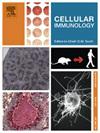A new chimeric protein composed by T-cell epitopes from peroxidoxin and pyridoxal kinase proteins is protective against visceral leishmaniasis
IF 2.9
4区 医学
Q2 CELL BIOLOGY
引用次数: 0
Abstract
Visceral leishmaniasis (VL) is a neglected tropical disease caused by intracellular protozoan parasites, and which present high incidence in populations in the world. The diagnosis is difficult to be performed, and treatment is toxic and/or presents high cost. In this context, prophylactic vaccination could help as an effective control measure against the disease. In this study, a new chimeric protein (LAV) was constructed with immunogenic T-cell epitopes from two immunogenic Leishmania proteins, and it was evaluated to protects BALB/c mice against Leishmania infantum infection. For this, animals were vaccinated with rLAV associated with micelles (Mic) or monophosphoryl lipid A (MPLA) as adjuvants; while the others received saline, rLAV, Mic or MPLA as controls. Results showed that the rLAV/Mic and rLAV/MPLA combinations induced higher cell proliferation indexes in stimulated cell cultures after infection, as well as the development of a polarized Th1-type cellular and humoral response before and after infection, which was based on the production of IFN-γ, IL-12, TNF-α, nitrite, and IgG2a isotype antibodies. In addition, both CD4+ and CD8+ T-cell subtypes were important for the IFN- secretion in both groups, as compared to the others. Control groups mice produced significantly higher levels of IL-4, IL-10 and anti-parasite IgG1 antibodies, suggesting the occurrence of a Th2-type immune profile in these unprotected animals. The parasite load was found to be significantly lower in mice vaccinated with rLAV/MPLA or rLAV/Mic, as compared to the others, by using a limiting dilution assay and qPCR. In conclusion, data suggest that rLAV plus adjuvant could be considered as a vaccine candidate in future studies to protect against VL.

一种新的由过氧化物毒素和吡哆醛激酶蛋白组成的t细胞表位嵌合蛋白对内脏利什曼病具有保护作用
内脏利什曼病(VL)是由细胞内原生动物寄生虫引起的一种被忽视的热带病,在世界上的人群中发病率很高。诊断困难,治疗有毒性和/或费用高。在这种情况下,预防性疫苗接种可以作为一种有效的控制措施。本研究利用两种免疫原性利什曼原虫蛋白的免疫原性t细胞表位构建了一种新的嵌合蛋白(LAV),并对BALB/c小鼠抗利什曼原虫感染进行了评价。为此,动物接种了与胶束(Mic)或单磷酰脂质A (MPLA)相关的rLAV作为佐剂;其余对照组分别给予生理盐水、rLAV、Mic或MPLA作为对照。结果表明,rLAV/Mic和rLAV/MPLA组合在感染后的刺激细胞培养中诱导了更高的细胞增殖指数,并且在感染前后产生了极化的th1型细胞和分泌反应,其基础是产生IFN-γ、IL-12、TNF-α、亚硝酸盐和IgG2a同型抗体。此外,与其他组相比,CD4+和CD8+ t细胞亚型对两组的IFN-分泌都很重要。对照组小鼠产生明显更高水平的IL-4、IL-10和抗寄生虫IgG1抗体,表明在这些未受保护的动物中发生了th2型免疫谱。通过使用限制性稀释试验和qPCR,发现接种了rLAV/MPLA或rLAV/Mic的小鼠的寄生虫载量明显低于其他小鼠。总之,数据表明,在未来的研究中,rLAV加佐剂可被视为预防VL的候选疫苗。
本文章由计算机程序翻译,如有差异,请以英文原文为准。
求助全文
约1分钟内获得全文
求助全文
来源期刊

Cellular immunology
生物-免疫学
CiteScore
8.20
自引率
2.30%
发文量
102
审稿时长
30 days
期刊介绍:
Cellular Immunology publishes original investigations concerned with the immunological activities of cells in experimental or clinical situations. The scope of the journal encompasses the broad area of in vitro and in vivo studies of cellular immune responses. Purely clinical descriptive studies are not considered.
Research Areas include:
• Antigen receptor sites
• Autoimmunity
• Delayed-type hypersensitivity or cellular immunity
• Immunologic deficiency states and their reconstitution
• Immunologic surveillance and tumor immunity
• Immunomodulation
• Immunotherapy
• Lymphokines and cytokines
• Nonantibody immunity
• Parasite immunology
• Resistance to intracellular microbial and viral infection
• Thymus and lymphocyte immunobiology
• Transplantation immunology
• Tumor immunity.
 求助内容:
求助内容: 应助结果提醒方式:
应助结果提醒方式:


